“I wanted to write about all generations, one century, several families and cities,” says Israeli author Moshe Sakal, describing the ambitious initial outline for his novel, “The Diamond Setter,” a work that took him six years to complete.
“The Diamond Setter” was first published in Hebrew in 2014, and this spring Other Press will release an English translation compiled by Jessica Cohen. The work is remarkable for its experimental structure, the cultural histories it highlights and the various taboos Sakal confronts. For English audiences, Cohen’s translation reveals an author who is grasping to understand the consequences of a violent epoch that has divided people based on their faith and ethnicity, yet has seen the birth of an eclectic democracy that is a beacon of light in an otherwise oppressed region. Grateful for the protections Israel offers certain minorities, especially the LGBTQ community, Sakal’s novel questions the extent to which Israelis are truly free to love, so long as physical and political borders bind them in.
Set in 2011, amid the trying first year of the interminable Arab Spring, Fareed, a young man from Damascus, ventures across the Israeli border. Determined to return an enchanted diamond called Sabakh to its rightful owner, Fareed is also on a mission to explore his family’s roots in the port city of Jaffa. Meanwhile, there is strident political and economic unrest brewing in Israel. Tom, a young writer who is apprenticed to an aging and financially distressed jeweler named Menashe, muses about the shop’s patrons. Tom’s multifaceted narrative reveals a forbidden love affair that began in the 1930s, connecting Fareed to the jeweler.
“Everything the reader believes is the truth,” Honi, an Israeli soldier and Tom’s lover, asserts during a literary conversation about the disjointed manuscript that Tom labors to complete throughout the novel. The statement asserts the leap of faith that readers must make if they are to enjoy “The Diamond Setter.”
“I always choose a narrator that knows much more than a standard narrator knows about the characters in the book. When you reveal a secret there is a bigger secret behind it,” Sakal tells JNS. This notion elevates the symbolism of Sabakh. As light refracts through the diamond at the center of the story, different plausible backstories emerge, revealing past deceptions with consequences that persist, thereby confounding the book’s present.

Although Sabakh effectively connects the sprawling web of characters in the novel, there is a certain rigidity to the symbolism of the diamond that renders it a weighty emblem of the past. By contrast, Sakal uses the dating app Grindr to introduce a modern element with the same capacity to bring characters together. Grindr is popular among the LGBTQ community, but Sakal could have chosen any app to draw the same circumferences of connectivity around his characters. Indeed, an internet dialogue with Rami, Fareed’s Arab host in Jaffa, is the catalyst that leads the Syrian to believe his “return” to Israel is both possible and worthwhile.
As Fareed begins to explore Israel’s LGBTQ community, however, new acquaintances are quick to describe a sense of emptiness underlying Israeli tolerance. Beware of “pinkwashing” Khaled, one of Rami’s Israeli-Arab friends, warns Fareed.
“Don’t go…and tell your friends how peachy everything is in the only democracy in the Middle East. Bottom line is we’re second-class citizens and it doesn’t make any difference that we’re allowed to fall in love with men and Israeli society accepts us,” says Khaled.
This brings the question of borders to the forefront, and demonstrates how communications technologies like Grindr undermine the social-political reality in Israel. Dating apps work as homing beacons for singles to discover partners in their vicinity. By bringing a diverse group of Arabs and Israelis together through this mechanism, Sakal prompts readers to ask: What happens when precise borders—such as a diamond might cut—disrupt the spiritual dimension that humans enter when seeking a soulmate?
“Dating apps in a country surrounded by borders create the ability to ignore these borders,” Sakal says. In “The Diamond Setter,” this concept inaugurates a sense of yearning for another time—before wars displaced populations, and when the free movement of peoples was still possible in the Middle East. As a consequence, readers are rendered hypersensitive to any description depicting societal divisions.
Influencing the work on a linguistic level, Sakal’s translator, Cohen, is careful to maintain even the most minute details distinguishing borders throughout the book. Depending on whether a chapter is told from the perspective of an Arab or a Jew, “We made a deliberate choice spelling Yafo (Jaffa) either with a Y as Arabs spell it or with a J according to the Hebrew spelling,” Cohen tells JNS.
Given the complex and bold nature of Sakal’s storytelling, there’s likely some truth to the author’s prediction that “The Diamond Setter” will be fully “understood in Israel only a century from now and by non-Israeli readers, much sooner.” Sakal knows he has probed contentious issues and that Israelis—seeking diversion in books—are often reluctant to read works that dwell on the intractable “situation” (the Israeli-Palestinian conflict) that haunts their daily existence. Thanks to Cohen’s rich translation, however, English readers hungry for a better understanding of the social, political and economic forces influencing the only democracy in the Middle East now have a jeweler’s loupe through which to view the country’s many facets.


























